Ambassador Jacobson traveled across Canada’s North, where he learned about the area first-hand with other ambassadors as part of the “2011 Northern Tour for Heads of Diplomatic Missions” hosted by DFAIT, Aboriginal Affairs and Northern Development Canada, and Parks Canada.
June 17, 2011: Iqaluit, Nunavut (63 degrees North)
I am beginning a very special trip. Every year, the Canadian Department of Foreign Affairs and International Trade (DFAIT) leads a trip for a group of about 25 ambassadors to the Canadian North. This is my year.
We assembled at the airport in Ottawa at 7:30 in the morning. Most of the ambassadors are already friends. I am confident when we return in 8 days we will all have bonded.
The trip goes to Iqaluit, Pond Inlet, Resolute Bay, Eureka, Kugluktuk, Inuvik, Dawson City, Whitehorse, Fort Simpson, Yellowknife, Churchill, Moosonee and back to Ottawa. I suspect if you are like me, you have never been to any of these places. And you may not have heard of some of them.
While I have been to Alert (which is as far north as you can go), I have not seen enough of the North. This is my chance.

Throat Singing
After a three hour flight we arrived in Iqaluit and went to a lunch with the Commissioner of Nunavut (the equivalent of the Lieutenant Governor in the Provinces) and a number of government officials and civic leaders. The highlight was when two Inuit girls demonstrated “throat singing” which is a unique set of very high and low sounds. Some of the songs are musical. Some mimic sounds. My favorite was the one they sang that sounded like a saw cutting through wood.

Nunavut Speaker's Chair
We then went to the Legislative Assembly Building. During the tour we each got to sit in the Speaker’s chair. Then we met with two government officials who gave us a presentation about the people of Nunavut, their government and some of challenges that the citizens face – poverty, high levels of domestic violence and suicide, low graduation rates, high TB rates, and lack of access to affordable food.

Lands End in Iqaluit
There is great natural beauty here, but the challenges that nature provides to the inhabitants is almost unimaginable. While Nunavut is a vast land mass, there are only 33,000 people. There are 25 communities ranging from Iqaluit with about 7000 to 14 communities with less than 1,000 people. Most amazingly, none of these communities are connected by roads. The only way to get to any of them is by plane -or if you are VERY hardy during the winter – by snowmobile or dog sled to a few of them.
A few things caught my attention.
First, the cost of living here is very high. There was a sign for 2 liters of milk for $12.75. Everything has to be flown in, including food, fuel, building material, etc. During a short period during the summer (not yet) the inlet does defrost and ships can get here. But there is no pier, so they have to unload on barges and float the supplies in.
Second, it doesn’t get dark here – at least during the summer. It’s10:30 at night and the sun is blazing, though it is getting a little colder, down to about 7 degrees Celsius. The last time I was in a place that had 24-hour daylight they had blackout shutters so you could sleep. They don’t here. Could be an adventure!
The other ambassadors and I had a good dinner together. We then went out to the location of the original town where there was once a Hudson Bay outpost: beautiful view.
DJ
June 18, 2011: Resolute Bay (74 degrees North)
Today was a very busy day. We started early in Iqaluit for a breakfast briefing by Parks Canada about the history and geography of the places on our trip. Then it was off to the airport to meet up with the twin engine prop plane we will have for the rest of our trip. We will be in the air for a total of 30 hours. Lots of flying.
The next stop was Pond Inlet, 72 degrees north. It was much colder outside than it was down south in Iqaluit which is only 63 degrees north. It was also stunningly beautiful. Pond Inlet is at the northern tip of Baffin Island. It was founded as a Hudson Bay trading outpost in around 1920. Today it has grown to over 1,000 people.

Welcome to Pond Inlet
We were greeted by the mayor and by a group of Canadian Rangers. I first came across the Rangers in Alert. It is a great program in which the Aboriginal community works with the Canadian military. They use their skills in dealing with the harsh climate in the North and they teach those skills to the military. In a place where jobs are in short supply, it is a win-win idea. The Rangers showed us some of their survival gear and seal and caribou clothing. Then they gave us some bannock, which is a very dense, fried bread. This trip hasn’t been good for my diet.

Canadian Rangers
We were taken out to the shore where the views were breathtaking. Then we went to the community center where we were treated to dancing, more throat singing and storytelling.

Pond Inlet Singing
From Pond Inlet we got back on the plane to fly to Resolute Bay. On the way we did a flyover of Beechey Island, which is where John Franklin wintered on his ill-fated search for the Northwest Passage. Three of his men died during the winter and they are buried on the island. (We could see the graves from the air.) After Franklin and his crew left Beechey, the ships disappeared and have never been found. As our guide explained, in Franklin’s day it was as if we had sent a rocket to the moon and it just disappeared.

Beechey Island
The first thing I have to say about Resolute is that it has my favorite name of any city in the world. What could be better than to say you were from Resolute? And since the population is 250, not many people can say that. The second thing I’ll say is that the place has a special meaning to many Americans. It is named after a British naval exploring ship, the HMS Resolute, which explored Resolute Bay in search of the Northwest Passage in the mid-19th century. In the winter of 1852, Resolute became beset in the ice and the crew was stranded for three years before being rescued. Several years later American whalers saw the HMS Resolute floating in the open waters. They sailed it to safety whereupon the United States refurbished her and gave her back to England. When the ship was finally decommissioned, Queen Victoria had a desk made of the ship’s timbers and gave it as a gift to the United States in appreciation for the ship’s rescue. Today the so-called “Resolute Desk” sits in the Oval Office and is used by the President of the United States. Some people have seen the Resolute Desk. Not too many have seen Resolute. I’m one of the very few who have seen both.
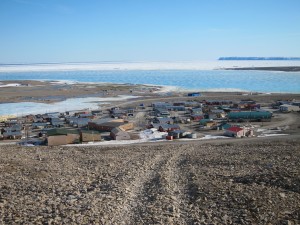
Resolute
In Resolute we started at the Polar Continental Shelf Project, which is a science lab set up by the Canadian government which can be used by scientists from around the world to conduct research in the Arctic.
Since my arrival in Canada, I have traveled a lot. Often when I go to another city, like Toronto, Montreal, or Calgary, I feel at home because I go to an event and I see familiar faces. Tonight I took that to a new level. When we got off the plane we were greeted by the director of the Continental Shelf Project whom I had met a year ago when he was with the Canadian Forces in Alert. Here we are in a remote village of 250 people, and the first guy I see is someone I know. It really is a small world.
After dinner we took a hike up the hill/mountain behind Resolute. (Since it is bright sunshine 24 hours a day you never have to worry about getting stuck in the dark.) The hike was challenging, at least for me. I took the wrong path down and that part was VERY challenging. But I made it back in one piece.
Tomorrow we go to Eureka!!!
June 19, 2011: Eureka, Ellesmere Island, (80 degrees north)
There is a famous story that Archimedes was given the task of determining the volume of an irregularly shaped object (supposedly a gold crown). The Greeks could weigh it, but they couldn’t figure out a way to determine its volume. One day he was getting into his bathtub and saw how the water rose. He realized he could measure the water his body displaced. He had solved the problem. As the story goes, he jumped from the tub and ran naked through the streets shouting “Eureka!” “Eureka!” “I found it!” “I found it!” Since then “eureka” has been synonymous with discovery.

Welcome to Eureka
Well today I found the northernmost place on our journey: the weather station at Eureka at the 80th latitude about 900 miles north of the Arctic Circle. It is the second most northerly inhabited place in the world next to Alert, which is about 140 miles further north. It’s not too inhabited, however. There are typically about 8 people who live there. But it is beautiful. And compared to Resolute, which is well south, it is much more lush. There are actually a few clumps of grass, some small wild flowers, and some wildlife. We saw musk ox, arctic hare, wolves and some birds. It was a balmy 11 C and windy.

Made it to 80
The weather station measures the various indicia of climate change which they share with researchers around the world. And they have amazing views.
One interesting Eureka fact: the satellite dishes don’t point toward the sky. They point parallel to the ground. It’s the furthest place north that can see geosynchronous satellites. Go any further and they are blocked by the horizon, even though they fly 22,000 miles over the equator.

Majestic Eureka
We then flew back to Resolute, because there is no place to stay in Eureka. We had dinner at our hotel, the South Camp Inn. The next time you’re in Resolute, I highly recommend that you stay there.
While you’re there, spend some time with Aziz the owner. He has an amazing story. He is Tanzanian, and he immigrated to Canada and lived for a while in Newfoundland. According to the story I was told, he came to Resolute because he heard there was a woman behind every tree. When he got here he was disappointed to realize that there were no trees.
In any event, things seem to have worked out just fine for Aziz. Not only does he have a lovely family, but he owns the hotel, he was the mayor, he’s on the school board, he owns the construction business, the repair business, the fuel business, the internet service provider, and pretty much every other business in Resolute. When the Northwest Passage opens for shipping and Resolute is the main port of call, I am assuming Aziz will become the Aristotle Onassis of Canada.
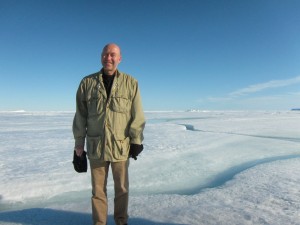
On the Northwest Passage
After dinner we decided to explore Resolute, which turned out to be an extraordinary experience. The first place we went was an area near the shore where archeologists had unearthed the remnants of Inuit homes used between 500 and 1000 years ago. They had stone floors and the roofs were supported by whale bones. They had very small entrances much like igloos that the occupants had to crawl through. This was partly to protect from the weather, and partly to protect from polar bears. The homes were all sized like small tents. The idea of surviving the Arctic cold in those tiny stone houses with some animal skins to keep you warm is unimaginable. There were fragments of bone everywhere. Some were huge — obviously whale bone — and some were much smaller.

Ancient Whale Bone Hut
We then went out on the frozen ocean and hiked out toward an iceberg that was trapped in the frozen surface. We were actually walking across the Northwest Passage. It was a thrill worthy of a group picture.
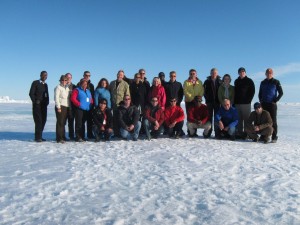
International Gathering on the Northwest Passage
We got back to the hotel and listened to an eye opening lecture about the geology of the Arctic and where and why oil, minerals, etc. might be found.
After that it was off to bed and a battle to fall asleep in the bright light of day.
DJ
June 20, 2011: Kugluktuk, Nunavut (69 degrees north) and Inuvik (68 degrees north)
We are headed south – relatively. To give you a sense, the top of Alaska is at about 69 degrees north. The Arctic Circle is at 66 degrees north. It’s still cold, and still 24 hours of daylight.
Speaking of cold, the late June weather so far on the trip has been mostly sunny, often windy, and between about 4 and 12 degrees C, but no rain. Actually, and this was a surprise at least to me, the places we have been to are very dry – almost desert like. It doesn’t snow much during the winter and there is very little rain in the “summer.” But what snow there is, it’s constantly blowing and drifting. When the snow does melt, it looks like the moon. There is little or no soil; it’s all rock. Most of it has eroded into small pebbles. There is a vast quantity of dust which is constantly blowing. When you drive on the few roads that exist – which are made out of the gravel – you leave a huge trail of dust. It is very inhospitable terrain, but the people are very friendly. And because there are oceans and mountains everywhere, it’s very, very beautiful.
Kugluktuk has 1,300 people, grass and a few bushes – the first real vegetation we have seen in a while! Our first stop was the Copper River. The local Inuit are known as the Copper Inuit because there is copper on the surface of the ground (but according to the mayor, it is not concentrated enough to mine). The Inuit used copper to make weapons and tools.

Welcome to Kugluktuk
Yesterday, the ice in the river had broken up and I learned about candle ice. The water on the surface melts through the ice, creating several foot long tubes that look like long candles. When the ice starts to shift it shatters like crystal. According to our guide, the noise yesterday as the ice broke up was memorable.

Candle Ice
Next, we went to the cultural center for a program of Inuit singing and dancing and had a lunch of Arctic Char soup and Caribou stew. We then went to the coop, the only store in town. It’s like a midsize supermarket with a good stock of clothing and other supplies. It also had milk for $12/liter. I guess that’s a bargain compared to some of the places we’ve been. Then it was back on the plane for the two-hour flight to Inuvik.
Inuvik is at the top of the Mackenzie River on the shores of the Beaufort Sea that borders the top of Alaska, Yukon, and the western part of the NWT. While that might seem pretty far north, it looked positively balmy to us. First of all, it was about 15 degrees. But more importantly there was grass and trees.
DJ
June 21, 2011: Dawson City and Whitehorse (60 degrees north)
The weather finally cleared and we flew to Dawson City. I was particularly excited to see it because our good friend Charlotte Gray has written a great book, Gold Diggers, about Dawson City and the Klondike Gold Rush. We were greeted by the mayor who was in white tie and tails. Not what I expected.
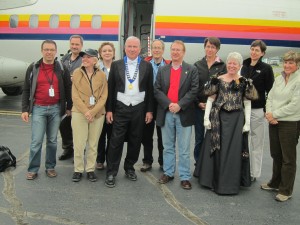
Welcome to Dawson City
The place looks a lot like it probably did at the turn of the 20th century. We spent a couple of hours walking around on the streets and several of us dropped in to a bar that hasn’t changed in a long time and has seen more than its share of interesting characters (though the patrons probably thought that about us, too).

Food on the Klondike
Because it was the summer solstice, which is also Aboriginal Day, there was a celebration going on. I particularly liked the bluegrass band.

Aboriginal Day in Dawson
Then it was on to Whitehorse. The headline here is that the Arctic is wildly diverse. First of all, there is the climate. It is much warmer here and there are forests, flowers, and grass. There is also a big difference in the level of development. Whitehorse looks much more like a small city down south. Highways. Stop lights. Hotels. Restaurants. Movie theaters. We had a presentation from Yukon government leaders where we learned that the economy here is very strong – driven mostly by the high prices of gold, silver, and other commodities. But one thing is the same: 24 hours of daylight. Can’t wait to see the dark again!!
DJ
June 22, 2011: Whitehorse, Fort Simpson, Yellowknife (62 degrees north)
We left Whitehorse early this morning. But one last story. At dinner last night, I was sitting with a couple who had been to Chicago to run in our marathon. There were 27,000 people in the race. There are 23,000 people who live in Whitehorse. Puts things in perspective.
The first stop of the day was Fort Simpson. On the way we flew over Virginia Falls. I had never heard of it. But it is about twice as high as the Niagara Falls and massive. It is just beautiful.

Welcome to Fort Simpson
Fort Simpson was a Hudson Bay trading post. They called most of their posts “forts,” but most were more like outposts. And many of the smaller towns and villages in the North are located where they are because of these “forts.” Fort Simpson is located in a beautiful spot at the confluence of the Mackenzie and the Liard rivers. There was a celebratory lunch with people from the 1,200-person community and a briefing from the Grand Chief and several of the local Chiefs. One told me that if you went across the Mackenzie and started walking east, you could go for 1,000 kilometers and not see evidence of humans.

The Fort Simpson Bird
This reminded me of something rather profound that one of our briefers had told us. Many of us – myself included – live in urban expanses with pockets of nature (which we call “parks”) sprinkled in. In the North there are vast expenses of nature, with small pockets of urban life sprinkled in.
Our next stop was Yellowknife. I’m told the place got its name because the Aboriginal people had knives made of copper, hence yellow knives. It is, by far, the most urban area we have visited so far. Tall buildings (8-10 stories) and lots of stores and there is even a McDonalds. The weather was much more summer-like – 29 degrees.
We had a briefing from Floyd Roland, the Premier of the Northwest Territories. We then had a dinner in the Prince of Wales Heritage Center with a group of business and political leaders from the NWT and had a tour of the museum. The main topic of discussion at my table centered on the amazing fishing in the area.
A full day.
DJ.
June 23, 2011: Yellowknife, Lac des Gras, Churchill (58 degrees north)
This morning we had a breakfast briefing from Capt. Sean Cantelon, the Deputy Commander of the Canadian Joint Task Force North, which is the part of the military that is responsible for the Arctic.
I get a lot of briefings on a lot of subjects. This one was one of the best. Capt. Cantelon began by explaining that the Canadian Forces role is to create a Canadian presence in the North. The exercise of sovereignty here is not kinetic in nature (guns, bombs, etc.), it is to demonstrate that this land belongs to Canada. He likened it to cutting your lawn. It isn’t evidence of hostility. It is evidence of the fact that the yard belongs to you. He explained that the threat in the North was not so much a conventional military one. The threat is the climate and the distance. He explained that the Arctic is a place where everyone is facing the same challenges together. Therefore, it can’t be a selfish place. It has to be a helping and sharing place. I was struck by the fact that these are many of the same words we have heard from the Inuit on this trip. They are a peaceful people who have survived through the centuries in the most difficult of conditions by working together.

Canadian Sovereignty
Unfortunately, we had to leave Yellowknife without visiting the Wildcat Cafe. Anyone who is a regular at the Museum of Civilization in Ottawa knows about the Wildcat. There is a replica of it in the museum which serves as a cultural icon of Canada. But the real one is in the process of being renovated. So, I’ll have to wait for my next trip to Yellowknife – or a visit to the Museum of Civilization.
After we left Yellowknife, we flew to Lac des Gras where the Diavik diamond mine is located. I have never been to a diamond mine and it is interesting. We started with a geology lesson. (If I get this wrong the geologists among you will correct me). Diamonds are found in kimberlite. Kimberlite is the dried lava of a certain type of volcano which became extinct tens of millions or hundreds of millions of years ago. It is surrounded by hard granite. Over time and under great pressure the diamonds were formed.

Midnight Sun Churchill
Then came the ice age. As the glaciers moved south they tore apart the land. Because the kimberlite is much softer than the surrounding granite, there were deeper depressions in the areas with kimberlite. When the ice age ended and the glaciers melted, the deeper depressions torn from the kimberlite were filled with water. Therefore, all the diamonds in Canada are found under lakes.
Several years ago a geologist found some kimberlite and related minerals to the south around Yellowknife. Scientists traced the path of the glaciers, and that set off a land rush to find the right lakes. The Diavik mine is in one of those right places. There are two other mines operating in the area with a fourth on the way.

Looking for Whales
Unfortunately, they didn’t let us take home any samples. So we got back on the plane headed for Churchill, Manitoba. I have always thought of Churchill as WAY north. It is — in fact — way south of any place we have been during the last week. And it is way-way south of places like Resolute and Eureka. But that didn’t make it any warmer. It was a couple of degrees above zero with a very strong wind. So the wind chill was way below zero–perfect weather for a boat trip.
We all piled into Zodiacs (small inflatable motor boats) to see the beluga whales that swim from the Hudson Bay into the mouth of the Churchill River. We saw scores of whales, which came within a few feet of our boats. There were even baby belugas (which hold great significance to anyone who has a small child and who has listened repeatedly to the song of that name). I’d show you a picture of the belugas, but I was way too cold and too wet to take any. After a long shower back at the hotel, several of us sat around the fireplace trying to thaw the permafrost in our extremities.
We then went to a dinner with community elders, Michael Spence, Mayor of Churchill and Eric Robinson, Minister of Aboriginal and Northern Affairs in Manitoba.
After dinner — since it is always light out — we were taken for a ride to see the countryside outside Churchill. And it wasn’t just a ride. It was a ride in a Tundra Buggy, which is this huge multiple-wheeled vehicle that is used to go out in the tundra to see polar bears in the fall. Its best feature which — to my knowledge — is unique, is a working fireplace. I’m not kidding.
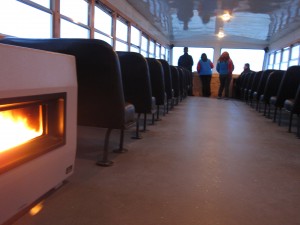
Fireplace on Tundra Buggy
On the way home we had a police escort with lights flashing. I have ridden in many motorcades. I’ve ridden in cars, in vans, in buses. But I have never ridden in a motorcade in a Tundra Buggy with a fireplace. And I doubt I will again.
After that kind of excitement we were all ready for bed.
DJ
June 24, 2011: Ottawa (45 degrees north)
Final day.
We woke up in Churchill. It’s still freezing but the sun was out. After a couple of briefings and a tour of the grain elevators at the port of Churchill, we assembled for our last group photo in front of an inukchuk on the shores of Hudson Bay.

Shores of Hudson Bay
Then it was back on the plane for the last five of our 30 hours of flight time on our 12,000 kilometer journey. We had to stop for refueling in Moosonee, Ontario.
We arrived back in Ottawa around 6:30 p.m. at which time I was greeted with my first cell signal since I left a week ago. As my family will gladly tell you, I am addicted to my Blackberry. The last week has caused me to go through Blackberry withdrawal. For the first few days I kept reaching into my pocket to check for email even though I knew there was nothing there. And all week I have never taken my beloved Blackberry off my person in the vain hope that we’d get service at any moment. So, I’m thrilled that I will have enough emails to keep me occupied all night.
So what did I learn in the North?
- Canada is an almost unimaginably big country.
- The Arctic is a very diverse place. Parts of it are barren. Others – at least during the summer – are much more hospitable.
- Climate change is having a huge impact in the North in very noticeable ways. Those changes will have huge and adverse consequences on the natural world and on the indigenous people. It will also present economic opportunities as resources as trade routes become more accessible.
- The only path to success in the Arctic — whether for people or for nations — is cooperation. It is just too hostile a climate and distances are too vast for anything else.
- Finally, the attachment the Canadian people feel towards the Arctic is understandable to anyone who has visited. It is a beautiful and majestic place with warm, friendly and brave people. I can’t wait to return.
Before I sign off, I want to thank Margaret Huber, the Chief of Protocol of Canada, and her entire team at the Department of Foreign Affairs and International Trade for organizing and leading this adventure. It has been flawlessly managed. Though we were occasionally poorly behaved, Margaret and her team kept our merry band of diplomats in line and in good spirits at all times.

Showing Off Our Gift Hats
For the first time in eight days it’s dark outside. I’m celebrating by going to sleep.
DJ



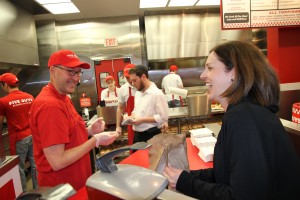




















































 Post Entries (RSS)
Post Entries (RSS)